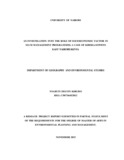| dc.description.abstract | Slums continue to pose the greatest challenges to the urban areas of developing countries
Kenya included. As a result, Kenya has an elaborate slum upgrading strategy which aims
inter-alia at improving the physical and social infrastructure and provide security of
tenure among the residents of Kibera. The success of the current slum management
strategy would however depend on whether the root cause of slums is understood and
whether past mistakes in slum management have provided sufficient lessons for those
who manage slums. Current slum upgrading strategy for example tend to emphasize the
physical aspect of the slum component: land tenure, and physical infrastructure. There is
current thinking among scholars that the past slum management strategies emphasized
the physical component and ignored the socioeconomic component, thus occasioning the
failure of past upgrading strategies. However details of what constitutes socioeconomic
components are not known. It is not clear what role the socioeconomic component plays
in the slum management process. This information is critical if slum management
approaches have to incorporate the socioeconomic component towards the slum
management process. This then formed the purpose of this enquiry; to determine the sub
components of the socioeconomic factors and the role they play on sustainable slum
management process. The study used culture of poverty and other related literature to
formulate a conceptual framework of understanding the role of socioeconomic
components. The framework was used to integrate the past slum management strategies
within the framework of the socioeconomic factor. The conceptual framework was also
used to interrogate the various forms of social and economic networks which constitute
the slum community. The study population in this research was the Kibera-Soweto East
slum dwellers where the upgrading program is currently underway. Interviews were
conducted and questionnaires distributed to obtain information from the respondents.
Secondary data was obtained from existing literature on the subject of study. Finally, the
study interrogated how useful these networks are among the residents of the slum
community. The study used SPSS and Excel to analyze data, and also t-test in testing the
study hypothesis. The study found that slum communities are poor, earn income which
barely covers the cost of living per month and this makes them vulnerable. Knowing their
problems, and to ease their burden they form and engage in various socioeconomic
networks which enable them survive and cope. Some of these networks include forming
welfare associations, “chamaas”. It was found that most of the slum management models
often end up relocating them, following which they lose ties and remain vulnerable hence
regrouping to form yet another slum community with similar ties. The current slum
management also focuses on the physical site ignoring the socioeconomic ties of the
community. This is seen as the cause of the failure of the past approaches and the likely
cause for the failure of the slum upgrading program. This study demonstrates that the
socioeconomic factor is critical among slum communities and slum management
programs should incorporate this integral component. | en_US |

